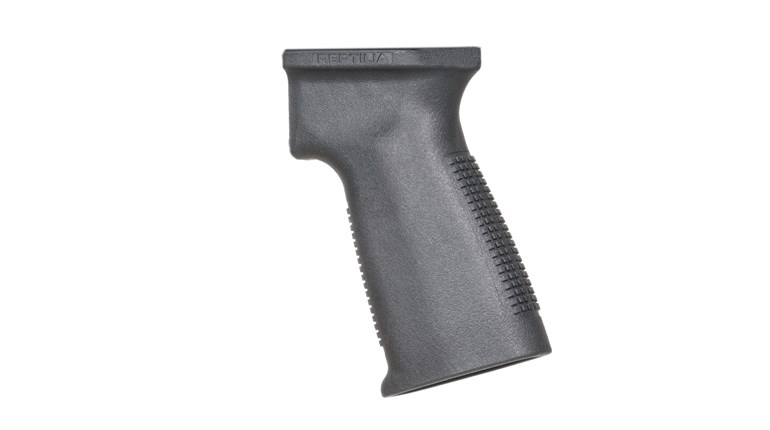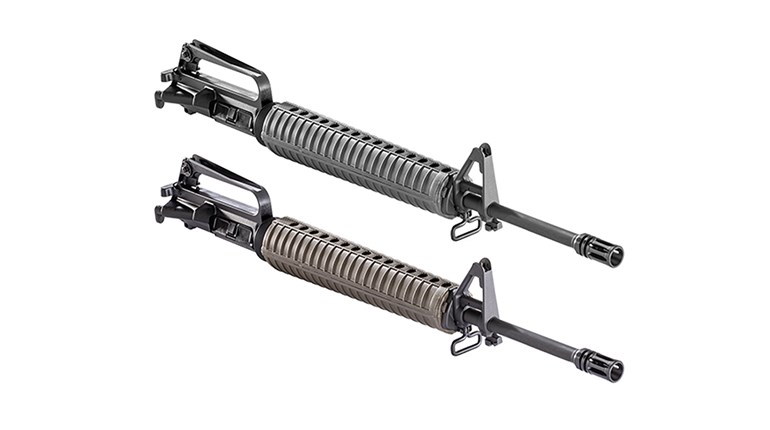
The story hit the presses in late May: Is the U.S. Army Outgunned in Afghanistan? As it spread, it threw more gas onto the long-burning firestorm of debate over the rifle and the round carried into combat by American troops. Continuously updated, the M16/M4 platform has been serving the U.S. military well for close to five decades. But from the rice paddies of Vietnam through the alleyways of Somalia and into the deserts of Iraq and the mountain valleys of Afghanistan, the worry has been much the same: Does the enemy have better guns than our troops?
To answer, we need to look at the guns our enemy in Afghanistan is using. Unsurprisingly, the primary weapon in the hand of Taliban militants, terrorists, and criminal fighters is the ubiquitous Kalashnikov AK series of assault rifles. Though commonly referred to, even by experts, as the AK-47, the majority of Kalashnikovs in use around the world are actually AKMs, or Modernized AKs. With a design optimized for mass production, the AK has been built by the boatload, not only by the Soviet Union but also by many other nations, many of which never really spent a lot of time bothering with licensing rights or royalty payments. Firing the 7.62x39 mm Soviet cartridge, the AK is a solid blend of simplicity, reliability and power. Handling is simple, operation is trouble-free and maintenance is barely required. It is the perfect weapon for uneducated users in hostile environments.
Teaching a peasant to load and shoot an AK only takes a few minutes, teaching him to hit anything with it takes a lot longer. In fact, the accuracy out of a typical AK, even in the hands of a marksman, is considered to be pretty pathetic when compared to the guns of modern militaries. The new army of Iraq, longtime users of the AK, is transitioning to the M16/M4 now that it is turning into a professional military, and it is not looking back. The AK is a solid weapon, but it is not what a professional soldier wants to rely on.
Though AK-47-pattern guns are the most common among enemy fighters in Afghanistan, another weapon that deserves a good look is the Dragunov SVD semi-automatic sniper rifle. Though appearing mechanically similar on the outside, the SVD does not share the AK's reputation as a so-so shooter. The SVD is deadly accurate even from long range, and one guy in the rocks overhead can cause a lot of problems for U.S. and NATO troops. It fires the 7.62x54 mm round, the Soviet equivalent of the .30-06 Sprg. And just as no one laughs at old World War I-vintage M1903 Springfield bolt-action rifles, no one laughs at the SVD. In the hands of a skilled marksman, the SVD is deadly. U.S. forces are seeing the value of an M14-equipped designated marksman in a rifle squad as a sort of "sniper lite," and Soviet/Russian forces have used the SVD in this manner for decades. Of all the small arms in the hands of our enemies, this is one of the few that measures up.
Older than even the AK, another Soviet-bloc weapon that shows up in the hands of bad guys and weapons caches is the PPSh-41 submachine gun with its distinctive barrel shroud. Used extensively back in World War II, this blowback-operated automatic fires the 7.62x25 mm Tokarev round. Though underpowered by many measures, it can be effective in close quarters and, since more than six million of the things were built back in the 1940s, they keep turning up all over the place.
Besides the mass-produced military arms from the remains of the Soviet Empire, there is a completely different category of guns encountered in the hands of the enemy. Copied from example weapons by a cottage industry of gun makers residing in the lawless region between Pakistan and Afghanistan, these "Khyber Pass Copies" are built from scratch and vary widely in quality. Many of the most-copied guns include the Martini-Henry and Martini-Enfield breechloaders and the Lee-Enfield bolt-action rifle. Available cheap in nearly every bazaar in the 'Stans, these knockoffs of British colonial-era firearms are often as dangerous to the shooter as they are to the target. Hilariously, the makers often try to ape the original manufacturing markings to add an air of authenticity, but their efforts are usually crude and obvious. Backward letters, uneven lines and supposed production dates decades after the last one was manufactured are clues that the gun's quality is somewhere in the range between really bad and horribly bad. Often unable to fire cartridges loaded anywhere near spec, guns bought as collector pieces are dangerous and should not be fired.
Though a bullet from an inaccurate AK or a handmade copy of a Martini-Henry fashioned from rusty car parts will kill just as easily as that from a finely crafted modern assault rifle, many of these guns are well beyond their shelf life and in the hands of poorly trained militiamen. Questions about the U.S. military's firearms are valid and worth discussing, but to make the case that the problem is the enemy's weapons outgun ours is pretty hard to take at face value. No matter what the shortcomings of the 5.56 NATO round out of a short M14 barrel are, no U.S. troops are looking for ancient AKs or Lee-Enfield copies to use instead.
And don't forget the old adage that people are always more impressed by enemy weapons than they are by their own—being on the receiving end is a more memorable experience.
The story hit the presses in late May: Is the U.S. Army Outgunned in Afghanistan? As it spread, it threw more gas onto the long-burning firestorm of debate over the rifle and the round carried into combat by American troops. Continuously updated, the M16/M4 platform has been serving the U.S. military well for close to five decades. But from the rice paddies of Vietnam through the alleyways of Somalia and into the deserts of Iraq and the mountain valleys of Afghanistan, the worry has been much the same: Does the enemy have better guns than our troops?
To answer, we need to look at the guns our enemy in Afghanistan is using. Unsurprisingly, the primary weapon in the hand of Taliban militants, terrorists, and criminal fighters is the ubiquitous Kalashnikov AK series of assault rifles. Though commonly referred to, even by experts, as the AK-47, the majority of Kalashnikovs in use around the world are actually AKMs, or Modernized AKs. With a design optimized for mass production, the AK has been built by the boatload, not only by the Soviet Union but also by many other nations, many of which never really spent a lot of time bothering with licensing rights or royalty payments. Firing the 7.62x39 mm Soviet cartridge, the AK is a solid blend of simplicity, reliability and power. Handling is simple, operation is trouble-free and maintenance is barely required. It is the perfect weapon for uneducated users in hostile environments.
Teaching a peasant to load and shoot an AK only takes a few minutes, teaching him to hit anything with it takes a lot longer. In fact, the accuracy out of a typical AK, even in the hands of a marksman, is considered to be pretty pathetic when compared to the guns of modern militaries. The new army of Iraq, longtime users of the AK, is transitioning to the M16/M4 now that it is turning into a professional military, and it is not looking back. The AK is a solid weapon, but it is not what a professional soldier wants to rely on.
Though AK-47-pattern guns are the most common among enemy fighters in Afghanistan, another weapon that deserves a good look is the Dragunov SVD semi-automatic sniper rifle. Though appearing mechanically similar on the outside, the SVD does not share the AK's reputation as a so-so shooter. The SVD is deadly accurate even from long range, and one guy in the rocks overhead can cause a lot of problems for U.S. and NATO troops. It fires the 7.62x54 mm round, the Soviet equivalent of the .30-06 Sprg. And just as no one laughs at old World War I-vintage M1903 Springfield bolt-action rifles, no one laughs at the SVD. In the hands of a skilled marksman, the SVD is deadly. U.S. forces are seeing the value of an M14-equipped designated marksman in a rifle squad as a sort of "sniper lite," and Soviet/Russian forces have used the SVD in this manner for decades. Of all the small arms in the hands of our enemies, this is one of the few that measures up.
Older than even the AK, another Soviet-bloc weapon that shows up in the hands of bad guys and weapons caches is the PPSh-41 submachine gun with its distinctive barrel shroud. Used extensively back in World War II, this blowback-operated automatic fires the 7.62x25 mm Tokarev round. Though underpowered by many measures, it can be effective in close quarters and, since more than six million of the things were built back in the 1940s, they keep turning up all over the place.
Besides the mass-produced military arms from the remains of the Soviet Empire, there is a completely different category of guns encountered in the hands of the enemy. Copied from example weapons by a cottage industry of gun makers residing in the lawless region between Pakistan and Afghanistan, these "Khyber Pass Copies" are built from scratch and vary widely in quality. Many of the most-copied guns include the Martini-Henry and Martini-Enfield breechloaders and the Lee-Enfield bolt-action rifle. Available cheap in nearly every bazaar in the 'Stans, these knockoffs of British colonial-era firearms are often as dangerous to the shooter as they are to the target. Hilariously, the makers often try to ape the original manufacturing markings to add an air of authenticity, but their efforts are usually crude and obvious. Backward letters, uneven lines and supposed production dates decades after the last one was manufactured are clues that the gun's quality is somewhere in the range between really bad and horribly bad. Often unable to fire cartridges loaded anywhere near spec, guns bought as collector pieces are dangerous and should not be fired.
Though a bullet from an inaccurate AK or a handmade copy of a Martini-Henry fashioned from rusty car parts will kill just as easily as that from a finely crafted modern assault rifle, many of these guns are well beyond their shelf life and in the hands of poorly trained militiamen. Questions about the U.S. military's firearms are valid and worth discussing, but to make the case that the problem is the enemy's weapons outgun ours is pretty hard to take at face value. No matter what the shortcomings of the 5.56 NATO round out of a short M4 barrel are, no U.S. troops are looking for ancient AKs or Lee-Enfield copies to use instead.
And don't forget the old adage that people are always more impressed by enemy weapons than they are by their own—being on the receiving end is a more memorable experience.






































